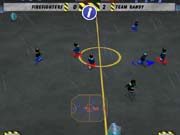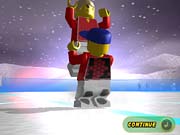Lego building bricks are as much a staple of late-20th century American childhood toys as Barbie, G.I. Joe, and Hot Wheels, but unlike these other toys, their appeal is primarily their potential to unlock a child's imagination as they take the bricks apart and rebuild them. There was a time when Lego pieces were sold by the bucket, to be built into a spaceship, a farm tractor, a hot rod, a boat, or a medieval castle, but over the years Lego sets have been released that are geared toward specific themes. One recent example of this is Lego Soccer, a series of toys that feature the classic Lego figures as soccer players in arenas built out of Lego bricks. To complement this line of toys, Lego Interactive created Soccer Mania, an arcade-style PC soccer game starring Lego characters. While the game can be fairly entertaining for a while, it does little more than slap little Lego people into a mediocre soccer game.

On the surface, Soccer Mania has everything it needs to give Lego fans an enjoyable alternative to playing with Lego bricks. The game can be played in several different modes, including quick start, exhibition, skill zones, Lego Cup, and story mode. Quick start and exhibition are basic game modes that let you get in, play a fast match, and get out. Skill zones--such as gate crasher, canyon chaos, and shoot the booty--are like tutorials that focus on specific controls or skills. Once you complete a skill zone, you unlock a new player to add to your team. Lego Cup is just a Lego version of the World Cup, in which you choose a team and enter a tournament that features 32 teams from around the world.
The story mode is a bizarre campaign that sets you on an extensive quest that is essentially a string of soccer games set in various Lego environments. The story begins with you winning a trophy after beating three teams, but before the trophy can be presented, Brickster, the villain, steals it and runs away. You must then embark on a quest to recover the trophy. Along the way, you will need clues or assistance from different Lego people, but for some reason these Lego people always challenge you to a soccer game before offering their assistance. Eventually you will chase Brickster through dozens of arenas from the tropics, to the arctic, and off into space--an admirable effort to recover a trophy.
While the story is enough to give a vague context to an otherwise random assortment of Lego people and places, the most entertaining part of the game is watching the scripted team celebrations after each goal. These celebrations include break dancing, dogpiles, airplane runs, and even suggestive horsy rides that push the boundaries of what can be shown in a children's game.
The soccer action itself is substandard. The controls and camera angles are less than ideal and make it difficult to pass and place shots accurately. The artificial intelligence of players on the field is fairly rudimentary, both on the opposing team and on your team. The soccer game itself is a simplified version of real soccer, with fewer players per team, a smaller field, and fairly short time limits. The field is surrounded by a plasma wall that lets players pass through but not balls--in other words, there are no out-of-bounds, no throw-ins, and no corner kicks. In addition, while there is a referee character on the field in every match, there are no penalties.
Players each have different attributes such as speed, dribbling, passing, and shooting, and as you progress through the story mode or unlock new players in the skill zones, you can upgrade your team. In addition to standard dribbling, passing, and shooting, players also have access to two special skill moves, one that lets them sneak by a defender and another that lets them perform an acrobatic overhead kick. The power-ups featured in the game add more options, like superspeed and exploding balls, which can be used when you collect them from the field.

Unfortunately the game is plagued with technical problems as well. On a test system that exceeded the recommended requirements, the game repeatedly slowed down during soccer matches and featured unreasonably long loading times in between matches. While the game does include 3D player models and arenas, instant replays from several angles, and some scripted 3D scenes, most of the scenes in story mode are static illustrations with voice-overs, which makes the long load times seem puzzling. To its credit, the game is colorful and bright and includes a diverse array of recognizable Lego characters and environments. The sound is decent, with appropriate sound effects and music that improve the arcade feel of the game. The voice-overs in between matches also add a European flair to the game, with brief announcer-style comments with a thick British accent.
Soccer Mania is geared toward children, but that doesn't excuse the problems with its controls, loading times, and slowdown. While the game may seem reasonably fun at first and offers an extensive number of options on three difficulty settings, it's unlikely that players of any age will want to play the game for very long.